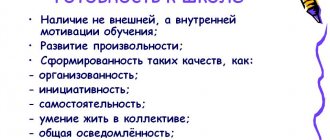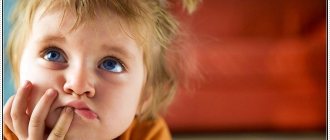- Tags:
- Recommendations from experts
- 1-3 years
- 3-7 years
- children in the family
- family relationships
Biting, pinching, hitting - in psychology, these manifestations are combined with the term “physical aggression”, which is not considered the norm in society and is subject to condemnation.
But this is for adults, but what should you do if a preschool child raises his hand against a parent? Is this acceptable? How to react? Let's try to figure out the problem. To begin with, it is worth understanding that no behavior is good or bad: psychologists never think in such categories. But by the child’s behavior they judge the problems he is experiencing and work with them. If your little son or daughter shows aggression towards his parents, then you do not need to scold him for bad behavior, but you need to figure out why he behaves this way.
Of course, there is no exhaustive list of reasons that force a child to beat his parents, because all children are individual. But there are some scientifically proven patterns of such behavior.
1) Expression of emotions.
A child is not a robot, but a living person, and therefore cannot not express emotions at all or express only joy. In preschool age, children's expressions of emotions are usually spontaneous, that is, children do not know how to control emotions, suppress them, or think about whether they are behaving correctly or not. Therefore, if a child feels anger or anger, one of his natural reactions is to hit the offender, even if it is a parent.
In addition, a child can express resentment, sadness, or boredom in this way, because he may simply not yet know other ways to express emotions. And if you do not allow a child to show expression, even in such a form as pinching and hitting, then he may lose basic life guidelines and may never learn to understand whether he is good or bad, whether he wants something or not.
The most correct thing would be not to scold the child, but to teach him to recognize his emotions. Ask him how he feels now. Discuss with your child what this or that emotion means. Offer other, alternative options for expressing feelings: draw resentment, imagine sadness, beat pillows, shout out the window.
Age characteristics
Through observations, it was revealed that the reasons that provoke such behavior in children may differ depending on age. Let's look at the main ones.
- If a child is one year old and hits his mother, then the main reason for this behavior is the lack of awareness of his actions, the baby is simply having fun in this way:
- indulges due to excess energy;
- studying the surrounding world, the capabilities of your body;
- way of expressing emotions;
- an attempt to draw mother's attention to his person.
- If a 2-year-old child hits his mother, then the following reasons for this behavior are possible:
- expression of emotions, inability to properly control oneself;
- to attract attention;
- way of expressing your disagreement or dissatisfaction;
- exploring the boundaries of permissiveness.
My niece, at the age of two, began to allow herself to hit her aunt or grandmother in the face one more time. This period passed quite quickly for her. Apparently, this was her way of trying to attract attention to herself.
- The fact that a 3-year-old child hits his mother is primarily explained by the period of confrontation with everything and everyone. At the age of three, it is important for a child to prove his independence and gain independence in his actions. If a baby raises his hand to you, this may be a consequence of the following prerequisites:
- way of showing your stubbornness;
- assertion that one is right;
- insistence on one's own opinion.
- A 4-year-old child most often displays this behavior because he is trying to get what he wants. It can also be a manifestation of resentment.
- A 5-year-old child will raise his hand against his mother due to the following factors:
- refusal to receive the desired item;
- the requirement to attract attention;
- copying other people's behavior.
2) Observation of physical aggression, violence.
In 1961, a group of psychologists led by Albert Bandura conducted an experiment that is known throughout the world as the Bobo Doll Experiment. Boys and girls with an average level of aggression took part in it and were divided into groups. One of the groups observed an adult’s aggression towards a doll (they beat it with a hammer, tossed it, threw it up, screamed), the second observed naturalness. It turned out that kids, in the presence of whom people behaved aggressively, copied this model of behavior, and in even more sophisticated ways: they hit the doll on the head, sat astride it, strangled it, and so on. This allowed scientists to conclude that if a child sees another adult showing aggression, then he “learns” to do the same.
The same experiment showed that if someone who shows aggression is scolded in front of a child, this will create an educational effect. The child will understand that this cannot be done.
Watching cartoons where Masha mocks the Bear with impunity, action films or games where you need to hit to win - all this only reinforces the child’s confidence that this can be done, so he allows himself to hit his parent, simply without thinking about it that is doing wrong.
It is customary in the family to use physical force
Unfortunately, in some families the use of physical force is considered the norm. Dad can hit mom in the middle of a quarrel, mom can slap her eldest son. At the same time, everyone speaks in a raised voice and may use obscene language. The most amazing thing is that when these people meet their neighbors, they smile sweetly and wish them a good day. Naturally, the younger children in such a family will express their emotions with their fists. Simply because their family doesn’t know how to communicate any other way.
Most likely, when younger family members grow up, they will also physically punish their children. If you contact a family psychologist in time, the situation can still be corrected. The question is that parents, as a rule, do not see this as a serious problem, because they are used to living this way.
3) Physical violence towards a child.
A child who himself becomes an object of aggression will more often show aggression himself. If a child is punished physically (and it doesn’t matter whether it’s slaps or painful blows), then the child’s appearance of aggression and the desire to hit back becomes natural.
Physical aggression can come from both parents and others, including other children. But it is not a fact that the child will respond with aggression to the offender. Received blows from another child in the sandbox can be redirected to an adult. So, if your child hits you but you have never physically punished him, try to find out if he was the target of aggression from someone else.
If your child has been in this situation, discuss the emotions they experienced. Tell him that when he hits you, it hurts you too. It may be worth discussing what to do if someone else hits your child.
If you yourself use physical punishment or “innocent” spankings, pinches, slaps in your opinion as education, then try to reconsider the options for punishment or the manifestation of your own emotions.
Baby doesn't get enough attention
If it is customary in a family to treat each other politely and respectfully, but the little robber continues to beat his parents, you need to analyze whether he has enough attention from adults. For example, the baby asks his mother to draw or read, and she is talking on the phone with a friend or preparing dinner. “Don’t bother me, watch cartoons,” “Can’t you see that I’m busy?” The baby does not receive the necessary portion of attention from his parents and is ready for any action if only mom and dad pay attention to him.
What should parents do? You must understand that preschoolers need more than just the basic needs that adults can provide (feed, bathe, comb their hair, dress them, put them to bed). Take a break from your obviously very important matters and spend time with your child. In the end, there is nothing more important than sincere communication with your baby. You can come up with so many interesting activities: sculpt together, draw, organize a puppet theater, organize a fashion show, or play repair shop. The main thing is that you work with your baby sincerely, with desire, and not because “it’s necessary.”
4) Checking boundaries.
The child is an experimenter. It tests the environment for what can and cannot be done. What will happen if I do this? What can you touch, what can you feel, how hard can you press?
Here it is important for the parent to help him set the right boundaries. Clearly outline the circle of what can be done and what cannot be done. To do this, you need to ask yourself: are you for or against your child patting you on the back, even if not hard? Can you do this with your hands, feet, or other things? It is quite likely that different parents will perceive the same actions differently: some as a joke or even a massage, others as pain and insult. Tell your child about this, explain what, in what situations and when it is acceptable and when it is not, and what will happen if he continues to do this.
When a child hits his mother
I tell you so often in different formats what to do with this that I got lazy and decided to write once in detail and provide a link.
So, we are talking about a child between 0.5 and 3.5 years old. At different moments of development and growth, he begins to test the boundaries of what is permitted. Particularly in this way. He hits, pinches, bites, and pulls mom, dad, and grandma by the hair. As a rule, at this age, events unfold within the family circle and do not yet spread to other children.
What to do. Naturally, the recipe is not universal, but in cases when it comes to testing boundaries, this is enough
1. Immediately after the blow, it is important to tell your child that you are hurt and you do not want him to hit you.
2. If the blow is repeated, try to intercept your hand.
3. If at this moment the child is in your arms, after the second attempt you need to let him go, again accompanied by the words that you are unpleasant about such treatment and you will not communicate under such conditions. Thus, we attach actions to words, demonstrating with its help the essence of words.
4. If a child cries, you can almost immediately take him back into your arms and feel sorry for him. After all, our task is not to punish and humiliate, but to explain. And by getting away with something unexpected for a child, you really upset him.
5. If, after you have picked up the baby, the blow is repeated, release him from your arms again, also, if possible, calmly explaining what exactly does not suit you. It is important to find words that make it clear that it is not the child who is bad, but his behavior that is unacceptable.
6. Naturally, after this attempt you don’t immediately pick it up. But it’s also not worth leading to hysteria. Next time you can pick it up, lightly holding the baby’s hands.
7. If the child is not in your arms, it is also important to distance yourself while accompanying the actions with words. Those. if you were playing together, stop playing; if he ran up and hit, leave the room.
8. If all this happens in the presence of other family members or friends, it is important that they either do not interfere in the situation or support the mother. In this case, it is better to feel sorry for the victim, completely ignoring the offender. Such an example demonstrates to the child that such behavior is not the most successful way to attract attention and, most importantly, that it does not work.
9. Consistency is important in all these actions. Those. If you can’t beat your mother, then you can’t beat her either in the morning, or in the evening, or on the street, or at a party, or in any other situations. As a rule, 2-3 weeks are enough to solve the problem.
Classic mistakes parents make when trying to deal with this behavior
1. “Hit back”: lightly hit the hand in response or spank. This is not true. After all, children copy the behavior of their parents. And in this way you demonstrate to the child that hitting is a completely acceptable way to express your dissatisfaction. What is not allowed for a child is not allowed for a mother either.
2. “Pretend to Cry” is a performance. If you don’t touch the fact of deception itself, then also the way mom portrays something is “entertainment” in itself. Especially in a year and a half. And there is a risk that the child will continue to repeat his actions in order to see the “performance”.
3. The same as point 2 concerns screaming, cries of pain, etc. If the child is not afraid, then he perceives what is happening as a “performance”. And he might want to repeat it.
4. Shame. “Shame on you,” etc. Shame is a social measure, which, if effective for educational purposes, is much later. For kids it's just a word.
At the beginning of the article, I wrote that this is often a test of boundaries. Naturally, in the case when the child does not see such treatment in the family. If he is beaten himself, or one of the parents may raise a hand against the other, then he should start changing the situation with himself.
5) Inability to show love to a parent in other ways
One of the ways to express love, sympathy, tenderness is physical contact - touching, hugging, kissing. It is possible that the child, by hitting you, wants to attract your attention in this way. Lack of attention and ignoring are more unbearable for a child than the parent’s reaction to aggression.
If a child starts hitting, pinching, or biting not after a conflict, but unexpectedly, then most likely he is waiting for your reaction and attention. Ask him if he wants to play. Try to express love and attention to your child in acceptable ways so that he learns to do this too: hug him, tell him about your love, tickle him.
Mistakes of inexperienced parents
Unfortunately, out of ignorance, a mother may behave incorrectly, thereby not only not solving the current situation, but also aggravating it.
- Don't try to shame your child.
- You can't give change. By your actions you will only confirm the permissibility of such an act. And if such behavior is aimed at attracting your attention, then your surrender will deeply wound the baby’s psyche.
- You should not act out a performance in front of your child and pretend that you are crying. The baby will be able to figure you out and will continue to beat his mother to see how she pretends to cry.
After reading the article, you found out why a child can beat his mother. Your task, as parents, is to figure out the reasons for what is happening and solve the problem that has arisen. Remember that you cannot physically punish a child for any disobedience; it is important to explain to the child in words the wrongness of his actions.
How to stop fighting with your parents?
Adhere to the same line of behavior as described above.
If the situation repeats frequently or in cases where the child continues to try to punish older relatives, it is better to consult a psychologist to determine the essence of the problem and the factor provoking such behavior.
Advice from psychologists:
- Don't confuse a baby's occasional slap in the face with someone trying to hit you. But in any case, do not turn such actions into games if you do not want the formation of an incorrect behavioral matrix.
- Pay attention to the point of uniform behavior of adults in this matter : any actions reminiscent of beating should not be used as an element of the game. Pillow fights, soft sword fights, boxing, and playful romp do not count.
- The first cases of pugnacity may be a sign of interest in the breadth of the boundaries of acceptable behavior and a desire to clarify one’s position in the “pack.” Therefore, do not panic, but simply explain that you cannot behave this way and that you are the main one in the family, not the child.
- Find out the reason for aggressive behavior.
If you are spoiled, urgently and categorically change your parenting methods. If there is an aggressive atmosphere in the family, look for a way to change the situation. If you identify an irritating factor in the form of aggressive computer games or movies, eliminate it. - Seeing the child's accumulating irritation, give him the opportunity to run around to his heart's content or get carried away by active play .
- Be sure to respond to unacceptable behavior and stop it at the beginning of the conflict.
- Always try to find out the reason for anger .
- Form in your child the concept that the feeling that has taken hold of him is anger and it is normal to feel it, but it is forbidden to manifest it in the form of physical punishment of someone else. Be sure to follow this line of behavior yourself.
- Don't sort things out in front of your child. He will perceive aggression without even understanding the meaning of the words, and will definitely work it out with you or someone from the environment.
How to behave?
Demonstrate to the child your dissatisfaction with the behavior using facial expressions and a stern voice.
It is advisable to block every blow with an interception, fix your arm or leg in the air and say out loud that you cannot behave this way.
In the absence of the desired reaction, warn the child about a subsequent retaliatory strike on your part if the child does not stop the attacks.
At the end of the acute phase of aggression, find out the cause of its occurrence and eliminate factors to prevent relapse.
It is important to get those around you (husband, other relatives) to adhere to the policy of resisting the child and humanely stopping aggression, and not encouraging him with statements like: “So she is!” Come on, come on! Here’s a naughty mom, come on, come on, spank her.”
The child is testing the boundaries
The baby is growing, exploring the world, and he needs to try and learn everything. Through aggressive behavior, he learns to understand what is good and what is bad. If a baby hit a girl on the playground, why can’t he hit his mother when she swears or doesn’t allow her to do something?
In this situation, child psychologists advise talking to the fighter and explaining that hitting and biting other people is unacceptable. Do not grab the baby by the hands, hit or pinch him back, or put him in a corner. This behavior will provoke an even greater attack of aggression. A strict prohibition (“I forbid hitting mom or dad”) can lead to the child starting to punish himself.
Typically, children bite their nails, pull out their own hair, give themselves bruises, and even bang their heads against the wall. You cannot force yourself to keep emotions to yourself, otherwise it may have a negative impact on the child’s fragile psyche. But how to teach a child to throw out negativity, and at the same time convey that parents should not be hit? Preschoolers feel well the emotions that mom and dad experience. For example, with the help of facial expressions, a mother can show that she is unhappy and upset. Only this must be done sincerely, truly expressing your emotions, and not playing a role.










